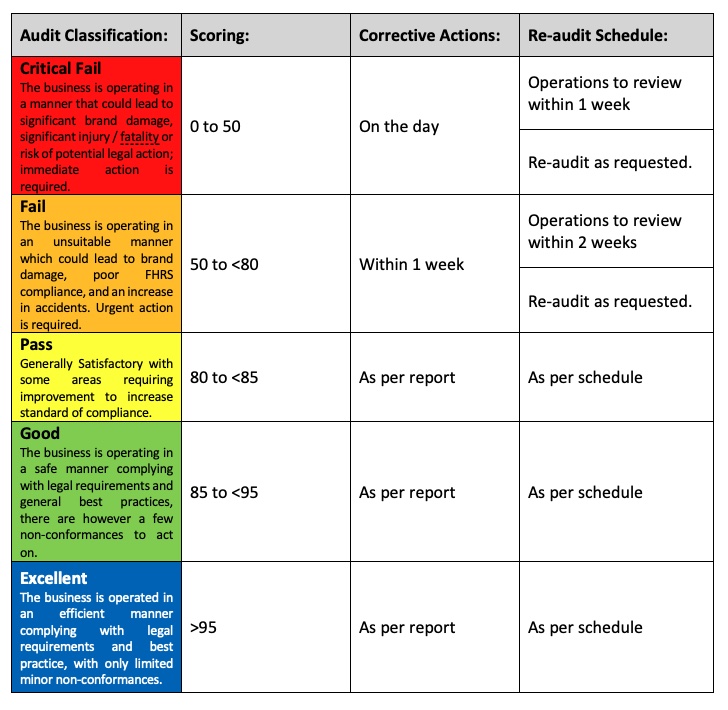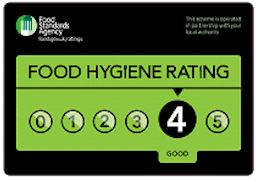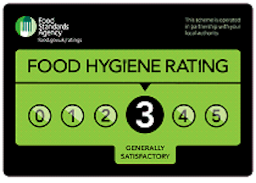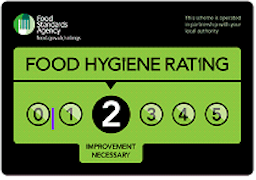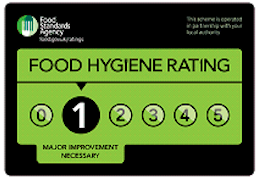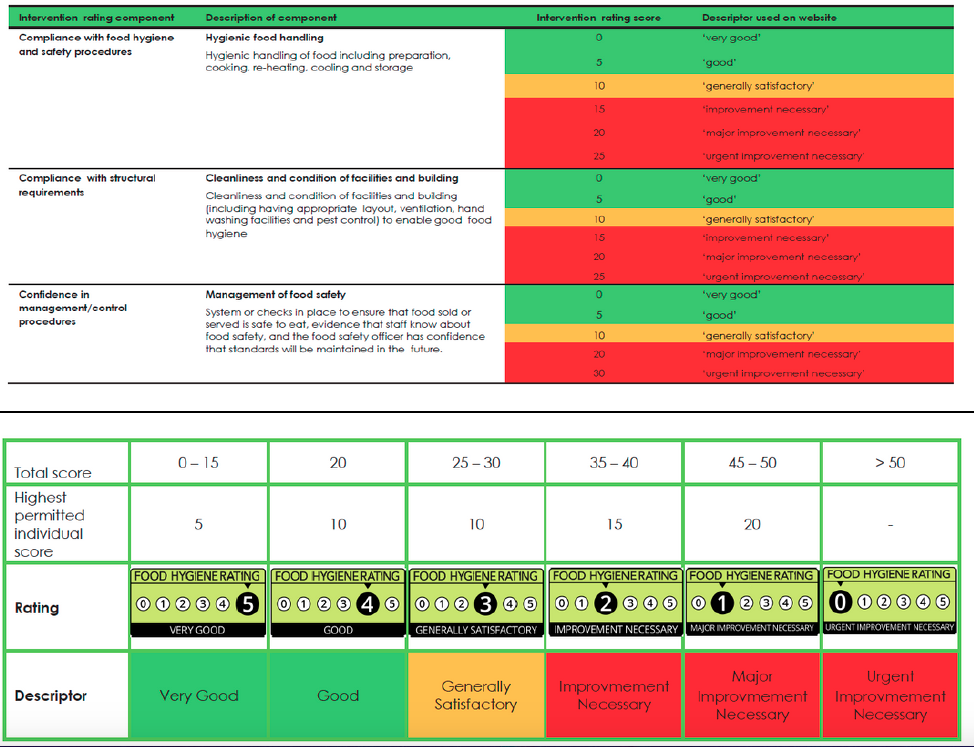Information
Information:
-
Client:
-
Site:
-
Address:
-
Date:
-
Business Manager:
-
Person(s) Met:
-
Prepared by
SUMMARY:
JUSTIFICATION SUMMARY:
-
The attached executive summary and information in the report highlights the key points identified from the audit, both good and bad practices and any major / critical issues noted.
-
Audit Classication
-
-
FHRS Score:
-
undefined
-
Food Safety:
-
undefined
-
-
H&S and Fire Safety:
-
Training:
-
undefined
-
Audit reinspection period:
Food Hygiene Rating (FHRS):
FHRS
-
Comments on FHRS score
-
Food Hygiene Rating Score:
- 5 - FHRS
- 4 - FHRS
- 3 -FHRS
- 2 -FHRS
- 1 - FHRS
- 0 - FHRS
-
0-15
-
20
-
25-30
-
35-40
-
45-50
-
This scoring guide defines the FHRS award that would be expected in the event of a live EHO inspection
-
Compliance with food hygiene and safety procedures: The hygienic handling of food by the Food Business Operator (FBO) in relation to food handling practices and procedures, staff personal hygiene, and effective temperature control. All necessary control measures in place to prevent cross-contamination and safe food preparation, cooking, re-heating, cooling and storage of food demonstrated.
- very good (0)
- good (5)
- generally satisfactory (10)
- improvement necessary (15)
- Major improvement necessary (20)
- Critical Improvement required (25)
-
Preparation and handling of foods (cross contamination):
-
undefined
-
Temperature Control:
-
undefined
-
Personal Hygiene:
-
undefined
-
Compliance with structural requirements: Cleanliness and condition of faciliites and building (including having and appropriate layout, ventilation, handwashing facilites, changing faciliites, effectve waste management, sufficient hot water and pest control) to enable good food hygiene.
- very good (0)
- good (5)
- generally satisfactory (10)
- improvement necessary (15)
- Major improvement necessary (20)
- Critical Improvement required (25)
-
Pest Control:
-
undefined
-
Design and provision of structure and facilities:
-
undefined
-
Cleaning and Hygiene:
-
undefined
-
Confidence with with management and control procedures: The systems or checks in place to ensure that food sold or served is safe to eat, evidence that staff know about food safety, and the food safety officer has confidence that standards will be maintained int he future.
- very good (0)
- good (5)
- generally satisfactory (10)
- improvement necessary (15)
- Major improvement necessary (20)
- Critical Improvement required (25)
-
Food Safety Management Systems (FSMS), Due Diligence and implementation:
-
undefined
-
Food Safety Training:
-
undefined
Food safety:
-
Food Safety: comments or observations that affect food safety at the restaurant?
FOOD SAFETY
1.0 PRACTICE AND CONTROLS (DUE DILIGENCE)
-
1.1 Delivery Procedures - Food is accepted in a properly controlled manner with the correct monitoring procedures being followed. Ensure that the Control documentation is being completed correctly and consistently?
-
1.2 Storage - Refrigerated and frozen storage temperatures are correct and control documentation is being completed correctly and consistently (Fridge <8°C, Freezer >-18°C)?
-
1.3 Defrosting - Carried out in a controlled manner in a refrigerator or time controlled ambient?
-
1.4 Preparation - High risk ingredients are not left at ambient temperature for excessive periods during preparation (30 minutes). Separation controls are in place for preventing bacterial and allergenic contamination?
-
1.5 Cooking / Reheating food - correct cooking / reheating temperatures (>75°C or equivalent) are being achieved and control documentation is being completed?
-
1.6 Cooking & Cooling - Correct cooking and cooling procedures is carried out in compliance with the <10C in 90 minutes. Control documentation is being completed correctly and consistently?
-
1.7 Hot Holding - correct Hot-Hold temperatures of >63°C are being achieved and control documentation is being completed or apply the 2-hour rule?
-
1.8 Cold Holding - correct cold- hold temperatures of <8°C are being achieved and control documentation is being completed or apply 4-hour rule?
-
1.9 Ambient Storage - High risk foods are not left at ambient temperature for excessive periods during service. Separation controls are in place for food safety and allergen management. If high-risk food is held out of refrigeration apply 4-hour rule - label with time?
-
1.10 If Vacuum Packing (VP) is in operation is a suitable control procedure in place. HACCP, cleaning and signage in place to minimise the risk of food-borne illness from cross contamination (multiple VP use)?
2.0 HACCP FOOD SAFETY MANAGEMENT
-
A spot check of all documented DD information and a visual check of procedures and practices.
-
2.1 All food safety control records maintained correctly and in a consistent manner. The records are stored in an orderly manner for monitoring purposes, to ensure that all CCP's adequately controlled to offer an effective due diligence defence?
-
Documents viewed:
-
2.2 Is there an up-to date and verified modular / product specific HACCP plan representative of the operation and products on offer?
-
Documents Viewed
-
2.3 All food businesses must have an Allergen Management System (AMS) that controls risk from allergen in the business especially 14 Major allergens. The AMS should included the Caterer HACCP, Allergen Risk Assessment• Practical Allergen Management• Allergen Communication.
-
Allergen Procedures:
-
2.4 Is there an approved supplier list on site with copies of accreditation documents available as required?
3.0 CLEANING AND DISINFECTION
-
3.1 All all parts of the structure of the food preparation area, tables, equipment, and ancillary areas maintained in a clean condition?
-
3.2 All food preparation equipment is stored and maintained in a clean hygienic condition and fit for purpose?
-
3.3 The Pot-wash area and dishwasher / area is clean with correct chemical dosage and wash and rinse water temperatures satisfactory at 82C; with clear segregation between clean and dirty equipment. If fitted is the grease trap / grease pack machine fitted and functioning effectively?
-
3.4 All cleaning equipment is stored and maintained in a clean hygienic condition and fit for purpose (mops clean and not in dirty water)?
-
3.5 Is there sufficient hot water to allow effective cleaning?
-
3.6 Adequate supply of sanitiser, to correct dosage and used appropriately; and do staff clean as they go?
4.0 PEST MANAGEMENT
-
Uncontrolled Pest infestation is a significant cause of restaurant closure, it is vital that pest issues are managed correctly
-
4.1 Are the premises free from infestation and from any visible signs of pests, have they been spotted and are pest issues suitably managed on site, have the recommendations on the pest control report been actioned?
-
4.2 EFK's - A sufficient number of EFK's is provided and sited correctly. The units are subject to a planned maintenance and cleaning?
-
4.3 External Openings - any windows or doors opening directly from an area in which open food is being prepared is fitted with adequate screening/brushes in order to prevent the ingress of pests. There are no cavities etc from disrepair which would allow access to pests. All doors are kept closed?
5.0 PERSONAL HYGIENE
-
Are team members changing gloves, washing hands, working in a safe manner to ensure that all food is produced to the safest and highest standard. WHB to be stocked with liquid antibacterial soap, Hot and cold water and drying facilities - suitable signage to be provided. Not consuming food or drink in kitchen.
http://www.food.gov.uk/sites/default/files/multimedia/pdfs/publication/fitnesstoworkguide09v3.pdf -
5.1 Are hand wash facilities sufficient, fully stocked with supplies and operating at an approximate temperature of between 40°C and 45°C? and are team members using the Wash hand-basin (WHB) effectively?
-
5.2 Are the personal habits of all team members suitable and sufficient at time of audit are they following the personal hygiene rules not picking at food or 'double dipping'. It is advised that disposable gloves are used for the direct handling of ‘ready to eat’ foods, If gloves are worn they must not be overused or misused in a manner to cause cross-contamination?
-
5.3 Are all kitchen personnel (food handlers) complying with the company policy on uniform, jewellery, hats and suitably coloured plasters?
6.0 WASTE AND REFUSE
-
6.1 Internal Storage: refuse is stored in a hygienic manner in the catering areas, storage bins are suitable and/or fitted with foot operated lids as required?
-
6.2 Housekeeping: The refuse is regularly removed from the catering areas so that no unacceptable build-up of refuse occurs?
-
6.3 External Storage: refuse is stored in bins fitted with a lid. The storage area is generally clean and tidy with no spillages or overflows of refuse likely to attract pests?
7.0 FOOD PREMISES DESIGN, CONSTRUCTION AND EQUIPMENT
-
The site shall be of suitable size, location, construction and design to enable the production of safe and legal products. It shall be suitably maintained and controlled to ensure that conditions hazardous to food safety (e.g. pest infestation) do not occur.
-
7.1 All structural surfaces are in good repair and comply with the requirements of food safety legislation. Ceilings, walls, doors and windows are sound and in good repair?
-
7.2 Adequate standards of lighting are provided to all work areas. All light fittings are correctly designed and in good repair. Are light diffuser covers fitted in food preparation areas?
-
7.3 Adequate ventilation is provided to the kitchen areas to ensure a comfortable and safe working environment. The optimum temperature for comfort within a catering establishment should be 19°C to 23°C.
-
7.4 All preparation and work surfaces are smooth, impervious and in good general repair to allow effective sanitising to take place.
-
7.5 Are adequate changing facilities provided to staff and is cleanliness and housekeeping satisfactory?
-
7.6 All sinks and wash hand basins are in good repair and provided with the correct facilities?
8.0 STORAGE AND LABELLING
-
All food must be stored at the correct temperature and labelled with the correct 'use-by' or 'best-before' date to meet both legal and company requirements.
-
8.1 Are all items suitably stored under the right conditions, labelled and dated in the fridge?
-
8.2 Are all items suitably stored, labelled and dated the freezer?
-
8.3 Are all items suitably stored, labelled and dated in the dry stores. The area is orderly with sufficient storage space and no foodstuffs stored on the floor. Opened packages are correctly protected within suitable containers. Is all food is adequately covered and protected from contamination during storage?
-
8.4 Good stock rotation is evident with the F.I.F.O. system being operated and no out of date foods being identified (following 3-day rule unless authorised)?
9.0 CONTAMINATION CONTROLS
-
9.1 Is separation of RAW and RTE foods in the kitchen adequate to control microbial contamination risks?
-
9.2 Is food handled correctly to minimise the risk of contamination and no foods exposed to excessive risk of contamination (Ph, Ch, Mb or All)?
-
9.3 Are probe wipes available and do staff know how to use and disinfect probe?
-
9.4 Is the separation of known allergens (14 Major) adequate?
-
9.5 Is the site using correct colour coded chopping boards to minimise cross contamination and are they stored in the correct manner?
FOOD SAFETY ISSUES NOTED AT SITE
-
Food Safety Issue No.
-
undefined
-
Identify food safety issue:
Health and Safety:
-
Health and Safety: Comments or observations on safety performance that need to be noted at the restaurant?
HEALTH AND SAFETY
10.0 WORKPLACE AND PREMISES
-
10.1 Is the available space in the building suitable for the operation, are floors marked on the level and/or low ceilings highlighted. Are floors an walkaways suitable and kept clear of obstructions?
-
10.2 Have changing facilities and lockers, suitable toilet facilities and an area for employees to take rest breaks been provided and If available a ‘Drinking Water’ tap is to be clearly identified and labelled for dedicated water system??
-
10.3 Are the external areas of the business under their control suitable and safe, if signage or decorative awnings are present are they visually safe and is the lighting level present sufficient to allow safe access and egress?
-
10.4 Is the temperature in the workplace suitable to ensure thermal safety and comfort?
-
10.5 Are there any landlord areas in use that pose a potential hazard, roof access, clear access or riser cupboards?
11.0 WORK AT HEIGHT
-
11.1 Are all work at height activities conducted safely or are there any significant safety failures?
-
11.2 Are ladders, steps or ‘elephants feet’ in good order and safe to use. Is a ladder checklist present and in use?
12.0 MANUAL HANDLING OPERATIONS AND ERGONOMICS
-
12.1 Are Manual Handling operations conducted in a safe manner?
13.0 GENERAL EQUIPMENT SAFETY
-
13.1 All equipment used in food preparation is constructed of correct material and maintained in good condition. ‘Dangerous Machines’ are provided with correct guarding, suitably sited and are emergency shut-off buttons free from obstruction and labelled?
14.0 FIRST AID AND ACCIDENT REPORTING
-
14.1 Is the first aid kit available and adequately stocked including eye wash solution (2x 500ml bottles)? and is a First Aid Notice is prominently displayed giving details of First Aiders available and their contact details; is the list current?
-
14.2 Accident Reporting - Is the accident book on site and are all accidents recorded in the accident book and company records maintained by sending to nominated person, with suitable accident investigation - All accidents are investigated and corrective action taken where necessary?
15.0 CHEMICALS (COSHH) AND HAZARDOUS SUBSTANCES
-
15.1 Documented systems. Are the COSHH risk assessments and chemical register present and valid, correct Material Safety Data Sheets (MSDS) are available for all chemicals?
-
15.2 Are the chemicals stored in a safe manner following the traffic light system and are all chemical used on site appropriate for their purpose and no unauthorised chemicals are present?
-
15.3 Is the correct COSHH required PPE on site, used and stored correctly (e.g. goggles gloves, masks aprons if required)?
-
15.6 Are the controls on site appropriate to manage the risk from Carbon Monoxide (Detector, WPRA and LEV test certificate (charcoal)?
-
15.7 Are the controls on site appropriate to manage the risk from Legionella on site, have any water checks been made and or testing completed?
16.0 SAFE WORKING PRACTICES
-
16.1 Is any equipment unsafe with obvious Safety Critical faults or defects?
-
16.2 Is the area free from any uncontrolled spillages or trip hazards and are the wet floor signs used correctly?
-
16.3 Are the knives used and stored in a safe manner?
-
16.4 Is the correct "safety" PPE on site, used and stored correctly (e.g. knife gloves and shoes)?
18.0 SAFETY SIGNAGE
-
18.1 Is a current Health and Safety law poster in place?
-
18.2 Is the general health and safety and COSHH safety signage adequate?
-
18.3 Does the business have a no-smoking sign and CCTV sign if present?
19.0 ELECTRICAL AND GAS SAFETY
-
19.1 Electrical equipment is visually safe, no damaged cables noted or observed?
-
19.2 Emergency isolation switches are provided and clearly marked?
-
19.3 is gas safety equipment visually safe and interlocked to extraction system?
-
19.4 is the boiler-room visually safe, suitable and sufficient?
HEALTH AND SAFETY ISSUES NOTED AT SITE
-
Health and Safety issue No.
-
undefined
-
Identify Health and Safety issue:






